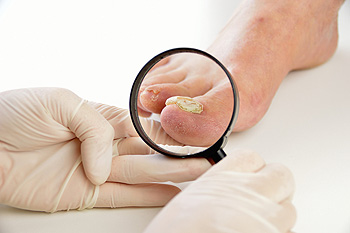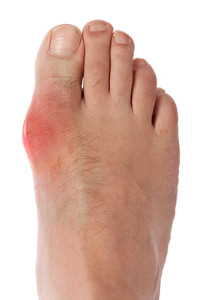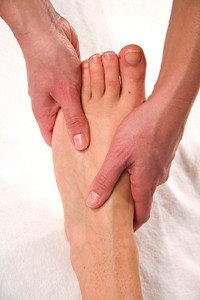 Another name for a common condition referred to as toenail fungus, is onychomycosis. General treatment options typically include using topical creams or liquids, despite being relatively ineffective. Recent research has shown the onset of using laser therapies, which may be an effective option for the treatment of toenail fungus. The concept may be an advanced approach, which may diminish the severity of this condition by injecting a specific amount of light into the affected toenail. There is insufficient information available than can justify the effectiveness of laser treatment and it has been suggested to consider this type of treatment when other remedies have failed. Please consult with a podiatrist for additional information about laser treatments.
Another name for a common condition referred to as toenail fungus, is onychomycosis. General treatment options typically include using topical creams or liquids, despite being relatively ineffective. Recent research has shown the onset of using laser therapies, which may be an effective option for the treatment of toenail fungus. The concept may be an advanced approach, which may diminish the severity of this condition by injecting a specific amount of light into the affected toenail. There is insufficient information available than can justify the effectiveness of laser treatment and it has been suggested to consider this type of treatment when other remedies have failed. Please consult with a podiatrist for additional information about laser treatments.
Laser treatment can be an effective way to get rid of toenail fungus. If you have any questions about laser treatment, consult with Brent Harwood, DPM from Southeast Podiatry. Our doctor will assess your condition and provide you with quality treatment for fungal nails.
What Are Toenail Fungal Infections?
Onychomycosis, or fungal infection of the nail, is a relatively common and non-serious condition. Around 10 percent of U.S. citizens are afflicted with fungal nails. Common forms of fungus that infect the nail include dermatophytes, yeasts, and molds.
Symptoms of Toenail Fungal Infections Include:
Diagnosis for Fungal Nails
Fungal infections are diagnosed by fungal culture and microscopy. This will rule out any other conditions such as nail trauma, psoriasis, lichen planus, and onychogryphosis.
What Is Laser Treatment?
Laser treatment is a non-invasive, safe, quick, and painless procedure that uses the heat from a laser to kill fungus in the nail. Each infected nail is targeted with a laser for several minutes. The treatment is usually utilized several different times over a select period. During this time, a podiatrist will keep an eye on the infection.
If you have any questions, please feel free to contact one of our offices located in Fairhope, Brewton, and Atmore, AL . We offer the newest diagnostic and treatment technologies for all your foot care needs.
Read more about Laser Treatment for Fungal Nails Gout is a form of arthritis that affects the joints and it is caused by an excess amount of uric acid in the bloodstream. A study was done to determine how gout is related to heart attacks, and it was found that the average time period between diagnosis of gout and myocardial infarction was 2.3 years. Gout has also been shown to increase the risk of getting a heart attack by three times. Surprisingly, gout was also shown to be a higher risk factor for myocardial infarction when other factors such as hypertension, diabetes, and heart failure were absent. If you have any questions or think you may have gout, please consider scheduling a consultation with a podiatrist.
Gout is a form of arthritis that affects the joints and it is caused by an excess amount of uric acid in the bloodstream. A study was done to determine how gout is related to heart attacks, and it was found that the average time period between diagnosis of gout and myocardial infarction was 2.3 years. Gout has also been shown to increase the risk of getting a heart attack by three times. Surprisingly, gout was also shown to be a higher risk factor for myocardial infarction when other factors such as hypertension, diabetes, and heart failure were absent. If you have any questions or think you may have gout, please consider scheduling a consultation with a podiatrist.
Gout is a foot condition that requires certain treatment and care. If you are seeking treatment, contact Brent Harwood, DPM from Southeast Podiatry. Our doctor will treat your foot care needs.
What Is Gout?
Gout is a type of arthritis caused by a buildup of uric acid in the bloodstream. It often develops in the foot, especially the big toe area, although it can manifest in other parts of the body as well. Gout can make walking and standing very painful and is especially common in diabetics and the obese.
People typically get gout because of a poor diet. Genetic predisposition is also a factor. The children of parents who have had gout frequently have a chance of developing it themselves.
Gout can easily be identified by redness and inflammation of the big toe and the surrounding areas of the foot. Other symptoms include extreme fatigue, joint pain, and running high fevers. Sometimes corticosteroid drugs can be prescribed to treat gout, but the best way to combat this disease is to get more exercise and eat a better diet.
If you have any questions please feel free to contact one of our offices located in Fairhope, Brewton, and Atmore, AL . We offer the newest diagnostic and treatment technologies for all your foot care needs.
Read more about Everything You Need to Know About Gout The feet typically endure years of wear and tear, and practicing good foot care will aid the feet in feeling comfortable. One of the ways this can be accomplished is to learn how to properly measure your feet so the correct size shoes can be chosen. Research has shown the feet are typically largest at the end the day, making it the optimum time to try shoes on. Additionally, it’s beneficial to try both shoes on to ensure a proper fit, because one foot is generally larger than the other. The shoes should feel good when initially tried on, and should not be expected to stretch out to feel it’s best. When the shoes are constructed of a soft material, possible skin irritations may be avoided. If you would like additional information about how to choose shoes that properly fit your feet, please seek the advice of a podiatrist.
The feet typically endure years of wear and tear, and practicing good foot care will aid the feet in feeling comfortable. One of the ways this can be accomplished is to learn how to properly measure your feet so the correct size shoes can be chosen. Research has shown the feet are typically largest at the end the day, making it the optimum time to try shoes on. Additionally, it’s beneficial to try both shoes on to ensure a proper fit, because one foot is generally larger than the other. The shoes should feel good when initially tried on, and should not be expected to stretch out to feel it’s best. When the shoes are constructed of a soft material, possible skin irritations may be avoided. If you would like additional information about how to choose shoes that properly fit your feet, please seek the advice of a podiatrist.
Finding a properly-fitting shoe is important in reducing injuries and preventing foot problems. For more information about treatment, contact Brent Harwood, DPM from Southeast Podiatry. Our doctor will treat your foot care needs.
Proper Shoe Fitting
A common concern when it comes to foot health, having properly fitted shoes can help prevent injuries to the foot. Out feet affect our posture and gait, which in turn affects the biomechanics and overall bodily structure. With 33 joints, 26 bones, and over 100 ligaments, the potential for serious injury is much greater than one realizes. Although the feet cease growth in adulthood, they still change shape as they mature. Here are some factors to consider when it comes to investing in proper fitting shoes:
Keeping in mind how shoes fit the biomechanics of your body, properly-fitting shoes are vitally important. Fortunately, it is not difficult to acquire footwear that fits correctly. Be sure to wear shoes that support the overall structure of your body. Do your feet a favor and invest in several pairs of well-fitted shoes today.
If you have any questions please feel free to contact one of our offices located in Fairhope, Brewton, and Atmore, AL . We offer the newest diagnostic and treatment technologies for all your foot care needs.
Read more about Proper Shoe Fitting Toenail fungus is a common ailment and may typically be noticed by the yellowing and thickening of the affected toenail. If left untreated, the nail may gradually turn black and may cause an unsightly appearance. There may be several reasons for this condition to occur, including sweaty feet caused by wearing shoes that do not allow enough air to circulate, or enduring specific health issues such as psoriasis or diabetes. The toenail fungus may cause an infection, and it’s suggested to consult with a podiatrist if the infection should become severe. A proper diagnosis can be performed, which may include testing a portion of the nail to determine the exact cause of the infection followed by discussing correct treatment options.
Toenail fungus is a common ailment and may typically be noticed by the yellowing and thickening of the affected toenail. If left untreated, the nail may gradually turn black and may cause an unsightly appearance. There may be several reasons for this condition to occur, including sweaty feet caused by wearing shoes that do not allow enough air to circulate, or enduring specific health issues such as psoriasis or diabetes. The toenail fungus may cause an infection, and it’s suggested to consult with a podiatrist if the infection should become severe. A proper diagnosis can be performed, which may include testing a portion of the nail to determine the exact cause of the infection followed by discussing correct treatment options.
If left untreated, toenail fungus may spread to other toenails, skin, or even fingernails. If you suspect you have toenail fungus it is important to seek treatment right away. For more information about treatment, contact Brent Harwood, DPM of Southeast Podiatry. Our doctor can provide the care you need to keep you pain-free and on your feet.
Symptoms
Treatment
If self-care strategies and over-the-counter medications does not help your fungus, your podiatrist may give you a prescription drug instead. Even if you find relief from your toenail fungus symptoms, you may experience a repeat infection in the future.
Prevention
In order to prevent getting toenail fungus in the future, you should always make sure to wash your feet with soap and water. After washing, it is important to dry your feet thoroughly especially in between the toes. When trimming your toenails, be sure to trim straight across instead of in a rounded shape. It is crucial not to cover up discolored nails with nail polish because that will prevent your nail from being able to “breathe”.
In some cases, surgical procedure may be needed to remove the toenail fungus. Consult with your podiatrist about the best treatment options for your case of toenail fungus.
If you have any questions, please feel free to contact one of our offices located in Fairhope, Brewton, and Atmore, AL . We offer the newest diagnostic and treatment technologies for all your foot care needs.
Read more about Toenail Fungus
 The condition referred to as flat feet which is also known as fallen arches, occurs when the arch is absent from the sole of the foot. As a result, the feet may point outward as the foot rolls to the inner side while standing or walking. Some patients may experience pain in the feet, and may vary in intensity depending on the severity of how fallen the arches are. There may be several causes of flat feet, including family history, an injury the foot or ankle incurs or certain types of arthritis. Most babies are born with flat feet and the arch will gradually appear as the feet become stronger when walking begins. It’s suggested to schedule a consultation with a podiatrist who can suggest treatment options for this condition, which may include wearing custom made orthotics.
The condition referred to as flat feet which is also known as fallen arches, occurs when the arch is absent from the sole of the foot. As a result, the feet may point outward as the foot rolls to the inner side while standing or walking. Some patients may experience pain in the feet, and may vary in intensity depending on the severity of how fallen the arches are. There may be several causes of flat feet, including family history, an injury the foot or ankle incurs or certain types of arthritis. Most babies are born with flat feet and the arch will gradually appear as the feet become stronger when walking begins. It’s suggested to schedule a consultation with a podiatrist who can suggest treatment options for this condition, which may include wearing custom made orthotics.
Flatfoot is a condition many people suffer from. If you have flat feet, contact Brent Harwood, DPM from Southeast Podiatry. Our doctor will treat your foot and ankle needs.
What Are Flat Feet?
Flatfoot is a condition in which the arch of the foot is depressed and the sole of the foot is almost completely in contact with the ground. About 20-30% of the population generally has flat feet because their arches never formed during growth.
Conditions & Problems:
Having flat feet makes it difficult to run or walk because of the stress placed on the ankles.
Alignment – The general alignment of your legs can be disrupted, because the ankles move inward which can cause major discomfort.
Knees – If you have complications with your knees, flat feet can be a contributor to arthritis in that area.
Symptoms
Treatment
If you are experiencing pain and stress on the foot you may weaken the posterior tibial tendon, which runs around the inside of the ankle.
If you have any questions please feel free to contact one of our offices located in Fairhope, Brewton, and Atmore, AL . We offer the newest diagnostic and treatment technologies for all your foot and ankle needs.
Read more about Flat Feet Foot pain on the inside of the foot is called medial foot pain, and foot pain on the outside of the foot is called lateral foot pain. It is most common for foot pain to be located on the outside of the foot. Lateral foot pain can be frustrating for those who enjoy being on their feet. The cuboid is one of the seven tarsal bones on the outside of the foot. An excess amount of traction over the cuboid can cause the tarsal bone to dislocate, which may result in cuboid syndrome. Pain for those with cuboid syndrome is usually experienced by those who participate in weight bearing activities. If you are experiencing any symptoms or have any questions regarding cuboid syndrome, please consider scheduling a consultation with a podiatrist today.
Foot pain on the inside of the foot is called medial foot pain, and foot pain on the outside of the foot is called lateral foot pain. It is most common for foot pain to be located on the outside of the foot. Lateral foot pain can be frustrating for those who enjoy being on their feet. The cuboid is one of the seven tarsal bones on the outside of the foot. An excess amount of traction over the cuboid can cause the tarsal bone to dislocate, which may result in cuboid syndrome. Pain for those with cuboid syndrome is usually experienced by those who participate in weight bearing activities. If you are experiencing any symptoms or have any questions regarding cuboid syndrome, please consider scheduling a consultation with a podiatrist today.
Cuboid syndrome, also known as cuboid subluxation, occurs when the joints and ligaments near the cuboid bone in the foot become torn. If you have cuboid syndrome, consult with Brent Harwood, DPM from Southeast Podiatry. Our doctor will assess your condition and provide you with quality foot treatment.
Cuboid syndrome is a common cause of lateral foot pain, which is pain on the outside of the foot. The condition may happen suddenly due to an sprain, or it may develop slowly overtime from repetitive tension through the bone and surrounding structures.
Causes
The most common causes of cuboid syndrome include:
Symptoms
A common symptom of cuboid syndrome is pain along the outside of the foot which can be felt in the and toes. This pain may create walking difficulties and may cause those with the condition to walk with a limp.
Diagnosis
Diagnosis of cuboid syndrome is often difficult, and it is often misdiagnosed. X-rays, MRIs and CT scans often fail to properly show the cuboid subluxation. Although there isn’t a specific test used to diagnose cuboid syndrome, your podiatrist will usually check if pain is felt while pressing firmly on the cuboid bone of your foot.
Treatment
Just as the range of causes varies widely, so do treatments. Some more common treatments are ice therapy, rest, exercise, taping, and orthotics.
If you have any questions, please feel free to contact one of our offices located in Fairhope, Brewton, and Atmore, AL . We offer the newest diagnostic and treatment technologies for all your foot care needs.
Read more about Cuboid Syndrome